
About UsThe Numismatic Bibliomania Society is a non-profit organization promoting numismatic literature. For more information please see our web site at coinbooks.org SubscriptionsThose wishing to become new E-Sylum subscribers (or wishing to Unsubscribe) can go to the following web page link MembershipThere is a membership application available on the web site Membership Application To join, print the application and return it with your check to the address printed on the application. Membership is only $15 to addresses in the U.S., $20 for First Class mail, and $25 elsewhere. For those without web access, write to: David M. Sundman, Secretary/TreasurerNumismatic Bibliomania
Society AsylumFor Asylum mailing address changes and other membership questions, contact David at this email address: dsundman@LittletonCoin.com SubmissionsTo submit items for publication in The E-Sylum, just Reply to this message, or write to the Editor at this address: whomren@coinlibrary.com
BUY THE BOOK BEFORE THE COINYou won't regret it! |
- WAYNE'S WORDS: THE E-SYLUM OCTOBER 25, 2009
- OCTOBER 17, 2009 CHARLES DAVIS SALE RESULTS AVAILABLE
- LAKE BOOKS 100TH MAIL BID SALE CLOSES OCTOBER 27, 2009
- NEW BOOK: FASCINATING FACTS, MYSTERIES & MYTHS ABOUT U.S. COINS
- BOOK REVIEW: LOOSE COINS
- MORE ON SPECIAL EDITION REDBOOKS
- U.S. MINT DIRECTOR JAY JOHNSON, 1943-2009
- COIN WORLD ARTICLE ON GOOGLE BOOKS AND NUMISMATIC RESEARCH
- DICK JOHNSON: NEW MEDAL, NEW BUSINESS, FINAL PART
- STACK'S 74TH ANNIVERSARY SALE
- JOHN FORD'S PRE-AUCTION MANEUVERING
- MORE ON AUGUST WAGNER AND THE 1913 LIBERTY NICKELS
- VOCABULARY WORD: CLICHÉ
- QUERY: COINS AND THE AMERICAN ECONOMY
- SAINT-GAUDENS' 1905 ROOSEVELT INAUGURATION MEDAL LEATHER POUCH
- QUERY: GREEK COIN BOOK SOUGHT
- 175TH ANNIVERSARY FESTIVAL FOR THE CASA DA MOEDA LISBON, PORTUGAL
- IS BRITAIN'S ROYAL MINT FOR SALE?
- LONDON NUMISMATIC MYSTERY: ARCHBISHOP'S COINS FOUND IN RIVER
- SOTHEBY'S OFFERS RARE GOLD 1920 FOOTBALL CHAMPIONSHIP MEDAL
- NEW ZEALAND WAR MEDALS THIEF SENTENCED TO ELEVEN YEARS
- CHINA GETS A TASTE OF COUNTERFEITING
- VOCABULARY WORD: NUMISMATISM
- WAYNE'S NUMISMATIC DIARY OCTOBER 24-25, 2009
- SHOPPING FOR BOOKS AT THE WONG FOOK HING
- FEATURED WEB SITE: COMMEMORATIVE COINS OF THE BANK OF RUSSIA
WAYNE'S WORDS: THE E-SYLUM OCTOBER 25, 2009

No new subscribers this week - we currently have 1,268 subscribers. Please pass the word - who do you know that would enjoy The E-Sylum?
It has been suggested that advertisements in The E-Sylum be grouped together in a single section like any other article. What do readers think? Opinions of the dealers who pay for the ads will be weighted heavily in the final decision, but I would like to hear from readers.
This week we open with updates from literature dealers Davis and Lake, and word of a new book by Bob Van Ryzin. In the news, a former U.S. Mint Director has died, Britain mulls privatizing the Royal Mint, and a Mint building in Lisbon celebrates its 175th anniversary.
We have several excellent submissions from readers including the conclusion of Dick Johnson's series on creating a new medal and business and Mark Borckardt's update on his 1913 Nickel research.
Forget the H1N1 flu virus - to learn about numismatism, read on.
Wayne Homren
Numismatic Bibliomania Society
OCTOBER 17, 2009 CHARLES DAVIS SALE RESULTS AVAILABLE

Our October 17 auction with consignments from Mssrs Vlack, Lorenzo and Hodder brought, with the buyer's premium, $102,000. Highlights included Hodder's presentation set of the 21 Ford sales which brought a not surprising $7,187.50. What was surprising was the contemporary photocopy of Bob Vlack's unpublished work on Hibernias @ $3,450, and Thomas Paine's "Thoughts on the Establishment of a Mint in the United States" @ $2,300 after the cataloguer, in his ignorance of never having seen a copy before, estimated it @ $200.
Ephemera, as usual, is impossible to estimate as shown by the Chapman announcement of the Stickney sale which drew three bids over $600 and settled at $685. Not surprising, the interest in large format Chapman catalogues, whether with reprint or original plates, remains strong. The price list is posted on our Vcoins website. Unsold items are available at 70% of estimate with no buyer's premium.
To read the complete article, see: www.vcoins.com/ancient/charlesdavis
LAKE BOOKS 100TH MAIL BID SALE CLOSES OCTOBER 27, 2009
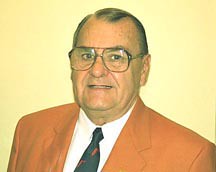 This is a reminder that our 100th mail-bid sale of numismatic literature will close on Tuesday, October 27, 2009 at 5:00 PM (EDT).
This is a reminder that our 100th mail-bid sale of numismatic literature will close on Tuesday, October 27, 2009 at 5:00 PM (EDT).
You can view the sale at: www.lakebooks.com/current.html
Please place your bids by email, FAX, or telephone before that time and remember that the earliest bid received wins tie bids.
NEW BOOK: FASCINATING FACTS, MYSTERIES & MYTHS ABOUT U.S. COINS
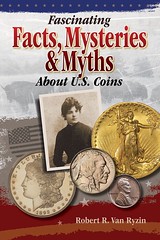 Robert R. Van Ryzin, editor of Coins, Coin Prices and Bank Note Reporter magazines, leads readers on an intriguing and entertaining journey through some of the most interesting stories of U.S. coin history, while uncovering many truths and just as many tales. For example, there's the one about the Ford Motor Company offering to give a car to anyone who found a copper 1943 cent. While it was a rare coin to find at the time, simply because the U.S. Mint changed from a copper composition to a zinc-coated steel version for that one year, the free Ford story was just a myth.
Robert R. Van Ryzin, editor of Coins, Coin Prices and Bank Note Reporter magazines, leads readers on an intriguing and entertaining journey through some of the most interesting stories of U.S. coin history, while uncovering many truths and just as many tales. For example, there's the one about the Ford Motor Company offering to give a car to anyone who found a copper 1943 cent. While it was a rare coin to find at the time, simply because the U.S. Mint changed from a copper composition to a zinc-coated steel version for that one year, the free Ford story was just a myth.
How about the story of noted numismatist J. Sanford Saltus' untimely death while cleaning his coins in 1922? At a time when coin cleaning wasn't frowned upon, it's said Saltus, president of the British Numismatic Society, was using potassium cyanide to clean silver coins he had just purchased and had ordered a bottle of ginger ale when he retired to his room that evening. Come the next day a glass with the poison and another with ginger ale were found on the dressing table of his room with a deceased Saltus beside them, according to the Numismatist. It's believed while cleaning his coins he mistakenly drank the poison instead of the ginger ale.
Among other facts, myths and mysteries featured in this book is the story of professed plagiarism in the design of the Roosevelt dime; rampant rumor of a recall of the Jefferson nickel released in 1938 due to the exclusion of the flag on the depiction of what appeared to be the White House -- which in reality was Jefferson's home, Monticello; truth and tales behind the redesign of the Standing Liberty quarter, and heated debate over the true identity of the models of the Saint-Gaudens gold $20 and the Indian Head nickel.
With so many stories to go around this book touches on some of the most noted and possibly notorious, while encouraging collectors, readers and historians to take a closer look at the past to discover how the present came to be.
In addition to serving as editor of three magazines for Krause Publications, long-time coin collector Robert R. Van Ryzin has also written Striking Impressions: A Visual Guide to Collecting U.S. Coins; Twisted Tales: Sifted Fact, Fantasy and Fiction From U.S. Coin History; and Crime of 1873: The Comstock Connection, and edited the CD "Silver Fever: The Comstock Lode to the Carson City Mint."
For more information, see: ShopNumisMaster.com
Joe Boling adds this word of caution about online ordering:
George Cuhaj, speaking of KP's new paper money books, says "There are great price reductions available if readers order on-line at shopnumismaster.com." But if book condition is important to you (as a bibliomaniac), DON'T buy online. The fulfillment house that is shipping Krause Publications titles uses a packing method that damages more covers than not. Buy your book at a show where you can select a pristine copy.
On a separate note, Joe adds:
Regarding the American Numismatic Society publications website, I immediately went there to see what the latest edition of Numismatic Literature is. I found "Numismatic Literature has been published quarterly from 1947 to 67, semi-annually from 1968 to 1999, and irregularly since 2000." That is thoroughly unhelpful.
BOOK REVIEW: LOOSE COINS
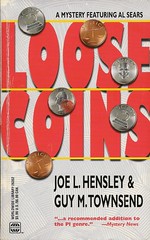 Last week I mentioned a novel Harry Waterson sent to me: "Loose Coins by Hoe Hensley and Guy Townsend (St. Martin's press, 2000). It was a busy week and I assigned the book to our staff reviewer, my father-in-law Kenneth "Red" Robinson. He's my hero - while I fight traffic and the rat race of work every day, he stays home watching TV and reading books. So I gave him the book.
Last week I mentioned a novel Harry Waterson sent to me: "Loose Coins by Hoe Hensley and Guy Townsend (St. Martin's press, 2000). It was a busy week and I assigned the book to our staff reviewer, my father-in-law Kenneth "Red" Robinson. He's my hero - while I fight traffic and the rat race of work every day, he stays home watching TV and reading books. So I gave him the book.
He finished it in a day. Always a master of the obvious, Red sez, "It's really good. You'd like it - it's about coins."
Brief, but to the point. His thumbs up is good enough for me. Look for it at your local library, flea market, or garage sale!
To read the earlier E-Sylum article, see: NUMISMATICS IN FICTION: 'THE COIN' AND 'LOOSE COINS' (www.coinbooks.org/esylum_v12n42a13.html)
MORE ON SPECIAL EDITION REDBOOKS
We'd like to take a moment to update E-Sylum readers on the special Philadelphia Expo edition of the 2010 Red Book. This version of the book was given as a gift to dealers at the 2009 Philly show, in honor of it being the first Whitman show in that venue, and extras are being sold to raise money for the National Federation of the Blind.
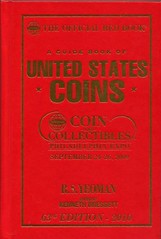
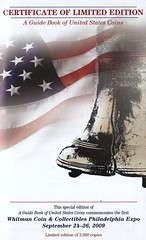
Copies are still available and can be "purchased" through Whitman for $50, to benefit the NFB (call 1-800-546-2995 and ask for the 2010 Philadelphia Expo Red Book, item #0794828191). All proceeds will be donated to support the Federation's efforts in Braille literacy and other programs. (We'd also like to remind collectors that the commemorative Louis Braille silver dollar issued by the U.S. Mint this year supports those same admirable programs.)
An anonymous writer in last week's E-Sylum misidentified the Guide Book of United States Coins, Professional Edition, as a "specialty version" or "collectible version" of the Red Book. I can understand his confusion since this is a new book building on an old title! The Professional Edition is actually its own animal --- an expanded resource that uses the same basic "look and feel" as the Red Book, but includes information aimed at intermediate to advanced coin collectors, professional dealers, auctioneers, investors, and researchers. This is very much a "workhorse" book; yes, it's pretty, but it's not supposed to sit in a safety deposit box as a collectible. It's a hands-on reference.
By the way, Ginger Rapsus's excellent article, mentioned in last week's issue, was "The Red Book Story," from The Numismatist 101, no. 9 (September 1988), pgs. 1561-1565. This is a great introduction to the Red Book as a numismatic collectible in its own right. Ginger's article was quoted several times in Frank Colletti's Guide Book of the Official Red Book of United States Coins (2009), which has been selling well and won a Numismatic Literary Guild award this year --- both good signs for numismatic bibliomaniacs.
Former American Numismatic Association Executive Director Bob Leuver adds:
I take exception to the writer who decreed that the Redbook is obsolete once it is printed.
I agree that coin prices change, sometimes dramatically, such as gold coins. The analogy is my computer, which is relatively new and the operating system is MS Vista. I did not chuck my computer the day after I bought it for, as everyone knows, computers become obsolete the first time you power them up.
The Redbook is a wonderful resource. I am not a dealer or avid coin collector, but I do research coins now and then. Perhaps several times a year I am approached by a novice collector or a widow, who has been left with a collection.
I always end up suggesting that the novice collector will learn something from the Redbook, or by comparing Redbook coin prices with past years. For that widow, I suggest coming to terms with a collection of U.S. coins by researching the Redbook, before contacting a dealer. These widows do not have collections that will inspire Heritage, Bowers & Merena or Stack's. But they are meaningful and have a value for the widows.
I have giving away more Redbooks than you will believe. I have none now. I have even given friends some prized books with Ken Bressett's personal inscription and autograph.
To read the earlier E-Sylum article, see: STOP! ENOUGH OF THE SPECIAL REDBOOKS ALREADY! (www.coinbooks.org/esylum_v12n42a06.html)
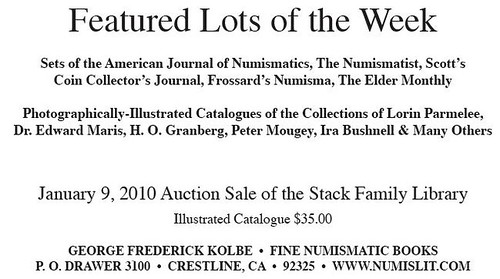
U.S. MINT DIRECTOR JAY JOHNSON, 1943-2009
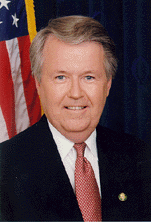 Former Wisconsin Rep. Jay Johnson, who spent three decades as a television journalist before jumping into politics and heading the U.S. Mint, has died. He was 66.
Former Wisconsin Rep. Jay Johnson, who spent three decades as a television journalist before jumping into politics and heading the U.S. Mint, has died. He was 66.
Johnson passed away Saturday night of an apparent heart attack at his home in suburban Washington, D.C., family spokeswoman Danielle Bina said Sunday.
"He could just light up a room," said Bina, who shared the anchor desk with Johnson in the late 1980s and early 1990s in Green Bay. "He could work a room like no one I've ever met. ... I would categorize him as having the biggest heart of anyone in the business."
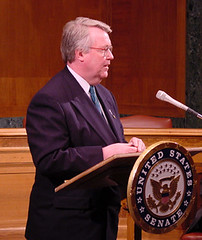 Johnson spent 32 years as a journalist in Wisconsin, Florida and Michigan before running for Congress. The Democrat was elected to Wisconsin's 8th District in 1996, and served on the House transportation and agriculture committees. He lost after one term to Republican Mark Green.
Johnson spent 32 years as a journalist in Wisconsin, Florida and Michigan before running for Congress. The Democrat was elected to Wisconsin's 8th District in 1996, and served on the House transportation and agriculture committees. He lost after one term to Republican Mark Green.
President Bill Clinton nominated Johnson to serve as director of the U.S. Mint in 1999, a position he held from May 2000 to August 2001. The next year he started Jay Johnson Coins and Consulting, where he developed a major wholesale coin sales program for a national bank, according to a biography on his Web site.
Before entering politics, he worked as an anchor and reporter at WLUK-TV and WFRV-TV, both in Green Bay. He also worked in markets in Florida and Michigan, and spent time as a disc jockey in Texas. The Michigan native also served in the Army as an information specialist from 1966 to 1968.
Bina, who used her maiden name, Kegel, when she worked with Johnson, said the two have remained friends over the years and just spoke a couple of weeks ago.
"Jay had a sense of humor and an outgoing, wonderful people-sense that was second to none," Bina said. "He was a kind, patient, wonderful guy."
Johnson is survived by his wife, JoLee, and two stepchildren. Funeral arrangements were pending Sunday.
To read the complete article, see: OBIT: Jay Johnson, 66, Former Wisconsin U.S. Congressman, TV Journalist, U.S. Mint Director Dies (www.grandforksherald.com/event/article/id/137664/)
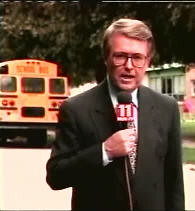 Many people knew Johnson from his days on the news. But those who knew him best, say there was much more to him.
Many people knew Johnson from his days on the news. But those who knew him best, say there was much more to him.
"He was a much broader, wider range person than most people knew or would give him credit for," said Paul Willems, who worked on Johnson's congressional campaigns and on his congressional staff. Willems said Johnson loved music and theater. Willems said Johnson's popularity propelled him from the anchor desk to Congress.
"He was a trusted figure and I think that's why he was elected," Willems said. "People certainly didn't vote for him based on his political experience. They knew him and they trusted him."
Johnson was elected to Congress as a Democrat in 1996. In Congress, Johnson served on the House Transportation and Agriculture committees. He served one term before losing to Republican Mark Green in 1998. Sidney Vineburg, chairman of the Democratic party for the 8th Congressional District, said that loss wasn't easy for Johnson.
"I think Jay really missed having been only a one term Congressperson," Vineburg said. "I think he really felt there was a lot more he could do."
After he left Congress, Johnson became the director of the U.S. Mint, a post he held for about one year. His most recent position was with Jay Johnson Coins and Consulting where he developed a major wholesale coin sales program for a national bank. Johnson worked as a consultant and returned to the airwaves, this time, promoting gold.
While Johnson is now gone, his memory will live on in the lives of those he knew.
"I'm sad," Bina said. "It just isn't the same without him."
To read the complete article, see:
Former Congressman Jay Johnson dies
(www.fox11online.com/dpp/news/local/green_bay/
local_wluk_greenbay_former_congressman_dies_101820091606_rev1)
Pete Smith writes:
In his first political campaign, he won election as a Democrat to the U. S. House of Representatives serving in the 105th Congress from 1997 to 1999.
Defeated for reelection, Johnson was appointed 36th Director of the U.S. Mint by President Bill Clinton. Johnson served from May 2000 to August 2001. In his role as Mint Director, Johnson attended ANA conventions.
Given the slightest provocation, the Numismatic Literary Guild (NLG) Bash will make fun of the Mint Director. In a pre-emptive strike, Johnson appeared at the 2000 NLG Bash to make fun of himself. In NLG skits, he appeared as a pitchman promoting the Mint's many products.
I also recall a parody of a bit popularized by comic Bill Saluga. "You can call me Ray, or you can call me Jay, or you can call me Jay Ray, … but ya doesn't hasta call me Mister Johnson." The humor of that suffers greatly when reduced to print.
I met Johnson during the 2000 ANA convention in Philadelphia. I found him to be remarkably friendly and approachable. The following year the convention was in Atlanta. Johnson and I left the Cobb Convention Center at the same time to cross the street to our hotels. We chatted during the walk and continued to chat on the street for about an hour.
After leaving the Mint, Johnson continued to attend numismatic conventions. He established Jay Johnson Coins and consulting in 2002. He developed a wholesale coin sales program for First Horizon bank and was business development consultant for Collectors Universe. In 2009 he became a consultant for Goldline International, Inc. and appeared on their website.
THE BOOK BAZARRE
COIN WORLD ARTICLE ON GOOGLE BOOKS AND NUMISMATIC RESEARCH
Digital technology may not render obsolete one of the most famous admonitions about collecting, to buy the book before the coin, but it could modify it.
Dozens upon dozens of hobby-related books and other publications are available, for free, through Google Books, the Internet search engine's digitization program.
The efforts of the program, though vexation to some academics and copyright holders, have been very fruitful, especially for numismatic research.
Some of the latest names in numismatic research give the program positive reviews.
Among these are Roger W. Burdette, R.W. Julian, Joel Orosz, Leonard Augsburger and David W. Perkins.
The latter three are also on the board of the Numismatic Bibliomania Society, a group of people that collect and advocate for numismatic books and periodicals - at least printed versions.
But these titans of the typeset have taken to high technology.
Congratulations to Jeff for a great, well-balanced article, and also to those quoted, E-Sylum readers all. -Editor
DICK JOHNSON: NEW MEDAL, NEW BUSINESS, FINAL PART
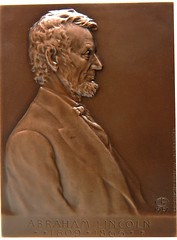 For two weeks I have related the saga of getting a new medal published. Setting up a new business and solving all the problems of issuing a new medal. There were peaks and valleys, satisfactions and frustrations. Meeting and joining forces with a savvy and intelligent partner. Working with an extremely talented artist / medallist. Seeing one's ideas come to fruition. Holding in one's hand that first-strike prototype. Those were the pleasures.
For two weeks I have related the saga of getting a new medal published. Setting up a new business and solving all the problems of issuing a new medal. There were peaks and valleys, satisfactions and frustrations. Meeting and joining forces with a savvy and intelligent partner. Working with an extremely talented artist / medallist. Seeing one's ideas come to fruition. Holding in one's hand that first-strike prototype. Those were the pleasures.
But there also were setbacks and frustrations. The worst were the interminable delays. Had we known these would occur, would we ever launch such a project? The thought kept entering our minds. I kept telling my partner, Mark Schlepphorst, "If it was easy, hundreds of other people would be doing it." But we took on the challenge. We pushed onward.
Mark and I had our plan set by November 2008. We wanted to issue a Lincoln / Brenner medal for 2009, obviously for the bicentennial of Abe Lincoln's birth -- and not overlooking the impressive centennial of the first issue of the Lincoln cent.
As mentioned in The E-Sylum last week working with medallist Don Everhart was a dream, a distinct pleasure. He is a real professional. He met every deadline we set. For concept, for initial drawing, for our nit-picking changes, for the final drawing, and for the finished clay model. He sent the plaster model to Bob Hoff at Medallic Art Company, all on schedule.
Dies were finished in December 2008. We were on schedule.
We were shooting for a medal in hand by Lincoln's February 12th birthday, the actual 200th anniversary, when we could release a photograph. But it was not to be. In our initial conversations with Bob Hoff, I estimated the plaquette we were seeking would require six blows on the press. Bob estimated nine blows. We were both wrong. It required 12 blows. "Don't skimp on quality," we told Bob, as we insisted we wanted the very best he could produce. We wanted them fully struck up with all the detail Don had initially put into his model. Bob's pressmen outdid themselves creating sharp images on every medal in our initial order.
That event cost us two month's time, however. We sailed past Lincoln's anniversary. Then came the decision about the patina. We had in mind a dark brown patina. We even sent Bob Hoff a sample medal with an unusual brown patina on a medal from the Great Religion medal series. Could he match this? Here again, we wanted the very best patina that could be placed on our medal.
We learned we wanted something that was not easy to do. Bob Hoff tried but could not satisfy us. Then we asked him to ship us the medals unfinished and we would have the patina craftsmen here in Connecticut (at Greco Industries) create the patina.
Bob was reluctant. He said with Medallic Art's name was on the medal as the producer, the patina should be done by Medallic Art. After several attempts to match the patina we had in mind, there was a negotiated change of mind, and the medal were shipped to Greco Industries for patination
The plaquettes arrived at Greco's Bethel plant in July. We did not know it at the time, but undoubtedly events we were unaware of may have caused the change of mind. Bob was negotiating with Ross Hansen to sell him Medallic Art Company. The announcement of the purchase was made July 17th
To their great credit, the patina craftsmen at Greco, the sons of patriarch Hugo Greco, the patina genius who had been the foreman at Medallic Art Co's finishing department decades before when MACO was in New York City, outdid themselves. They came up with an entirely new, most attractive, highly significant patina especially for this medal. They created a dark brown patina we were seeking. It required several applications but we got something that had never been done before, a brown with a tinge of red. We named it a "double brown-red chocolate patina."
But wait! We still couldn't release the medals. We couldn't run the advertisement I had written months before. The U.S. Mint's legal gurus were concerned about Don Everhart, and the fact he was a U.S. Mint engraver / sculptor, being associated with a Brenner Lincoln medal and the connection with the Lincoln Cent. Without that we were lost. Another month's time lost.
Don had gotten clearance from his superiors at the Mint before starting our project. He assured them that he would do this on his own time, which he did. Now the US Mint lawyers were putting the issue of our medal on hold. We saw tens of thousands of dollars lost.
My partner remarked how it would be ironic if this played out as a repeat of the 1909 Lincoln Cent and the controversy and subsequent removal of Brenner's initials – VDB – from the reverse die. It was a matter of giving credit to a deserving artist.
Ultimately, my partner, in his best negotiating ever, finally got the Mint's and Treasury's lawyers to agree we could release our medal provided we use the disclaimer we were not affiliated with the U.S. Mint.
Finally we can release our medal. Press releases went out, followed by our ads. Hey, it is still 2009! Go to our web site and order our plaquette for the sheer enjoyment of an outstanding medallic honor to Lincoln and Brenner. Click on SignatureArtMedals.com .
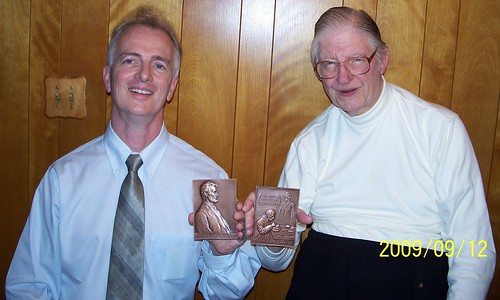
To read the earlier E-Sylum article, see: DICK JOHNSON: NEW MEDAL, NEW BUSINESS, PART TWO (www.coinbooks.org/esylum_v12n42a08.html)
STACK'S 74TH ANNIVERSARY SALE
New York. J.J. Benson. 25¢
From the Alan Bleviss Collection of Civil War Tokens.
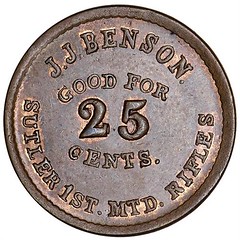
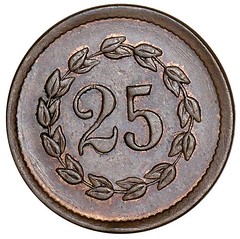
New York. J.J. Benson. 25¢ (www.stacks.com/lotdetail.aspx?lsid=AN00000726&asid=AN00000281&lrid=AN00153239)
1790 Standish Barry threepence
The obverse portrait, recently identified as Baltimore Mayor James Calhoun by Max Spiegel, is well defined and all legends are clear.
The Barry threepence's distinctiveness may be at the heart of its desirability on equal terms as its rarity. It's the only silver portrait piece of the 18th century, matched only by the Lord Baltimore series a century earlier. This is the only issue by Standish Barry, and it is the only early American coin to show a precise date. The long-time enigma of the portrait added a curious mysteriousness, magnified by the fact that many of the known specimens show indistinctly struck or well-worn portraits.
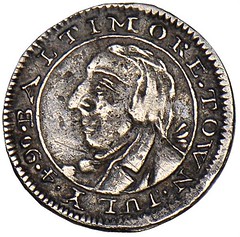
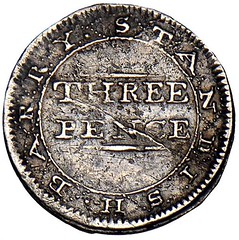
1790 Standish Barry threepence (www.stacks.com/lotdetail.aspx?lsid=AN00000726&asid=&lrid=AN00154280)
1861 Confederate States of America Cent
In brief, the man who made them, Philadelphia engraver Robert Lovett, Jr., stated that 12 original pieces were struck in copper nickel. These were kept by him and never delivered to Bailey, as he feared retribution by Union authorities, the Civil War having begun (on April 11, 1861). However, even at the beginning of the war no one knew for sure whether commercial trading between the North and the South would be allowed while, separately, troops engaged in battle.
Accordingly for a time there were some contacts made in all innocence. Later, the federal government took a stand against this and, for example, marched upon the American Bank Note Company and the National Bank Note Company, both in New York City, and seized plates used for Confederate bonds and for paper money, the last from National, the plates mentioned above.
The number of original 1861 Confederate cents known, struck in copper nickel, cannot be more than 12. Whether all those can be accounted for is not known.
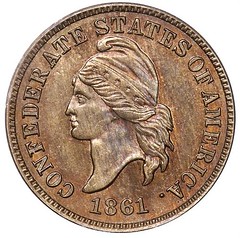

1861 Confederate States of America Cent (www.stacks.com/lotdetail.aspx?lsid=AN00000726&asid=&lrid=AN00157252)
Royal Shoes, 21 Church Street, New Haven, Connecticut
Printed on thin bond paper. Brown overprint on face, portrait of A.G. Spaulding to left, standing batsman to right. Brown back depicts portraits of 12 Chicago White Stockings players with inscription ("THIS BILL IS GOOD / for FIVE per cent in payment …").
Albert G. Spalding was the manager of the National League Chicago White Stockings, the predecessor club of the Chicago Cubs. Though Spalding is best known as the founder of the sporting goods company that even today bears his name, he compiled a .796 winning percentage as a pitcher and won 253 games. By 1889, he was the owner of the club; their record of 67-65 was good for third place in the NL. Among the players depicted on the back of this type is Cap Anson, who served as manager, first baseman, and minority owner of the team in 1889. Anson, the first player to pile up 3000 hits, entered the Baseball Hall of Fame along with Spalding.
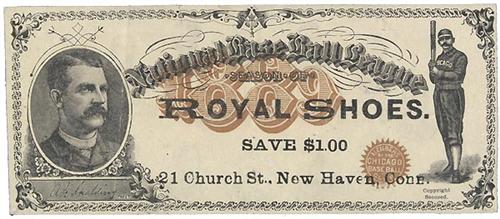
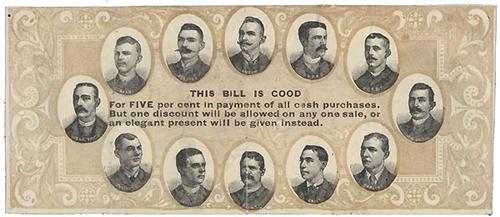
Royal Shoes, 21 Church Street, New Haven, Connecticut (www.stacks.com/lotdetail.aspx?lsid=AN00000726&asid=&lrid=AN00157163)
JOHN FORD'S PRE-AUCTION MANEUVERING
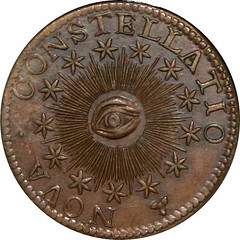
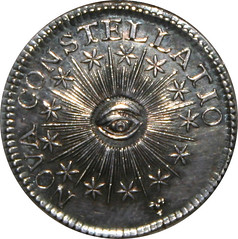
Neil Berman writes:
I have been following this series on John J. Ford and the Nova Constellatio patterns and I have to say I have rarely read more propaganda than what has been printed in these columns. First, Ford openly (and I add in a most arrogant manor, almost proudly), told a number of collectors that day on the auction floor that he believed that all the Nova coins were fake in order to lessen competition, and Melnick (who was a personal friend of mine), was none to happy to play a part.
While no one can lessen the shear amount of information Ford knew, or his stature in the coin community due to the impact of his collection, his ethics are questionable. And you can quote me.
To read the previous E-Sylum article, see: MORE ON THE 1783 NOVA CONSTELLATIO PATTERN SET (www.coinbooks.org/esylum_v12n42a10.html)
MORE ON AUGUST WAGNER AND THE 1913 LIBERTY NICKELS
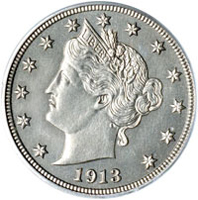
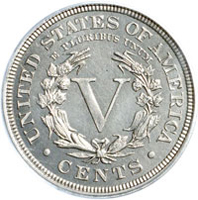
In December 1923 and early in 1924, August Wagner advertised the five 1913 Liberty nickels for sale. His address was 31st and York Sts., Philadelphia. Past authors have called Wagner a coin dealer or a stamp dealer, giving no further clues about who he was. Former ANA Historian Jack Ogilvie stated in a letter to Eric Newman that Wagner was never an ANA member, even though his advertisements ran in The Numismatist.
I have recently learned a little more about Wagner. An image of his World War I draft card on www.ancestry.com gives his residence as "NE cor. 65th and Camac" in the community of Oak Lane, and his business address as "NW cor. 31st and York." Ancestry.com is a wonderful website, useful for more than just family history.
Wagner is listed in the 1910, 1920, and 1930 Federal Census records as a real estate broker. He was born in Pennsylvania on April 26, 1881, married to Alice (maiden name unknown), and was the father of five children. In 1942 he filled out a World War II draft registration card. In 1950, Mrs. August Wagner is listed alone at their residence address according to a Philadelphia City Directory. Therefore, it appears that August Wagner died sometime between 1942 and 1950. While it is certainly possible that Wagner dealt in coins and stamps, it seems that real estate was his primary business.
he 1913 Liberty Head Nickel is one of the most valuable coins in the world. Only 5 specimens are confirmed to exist, although there is an intriguing hint that there might be a sixth. The finest-known 1913 Liberty Nickel is valued at a minimum of $5 million, the price for which it sold in May of 2007.
On the face of things, you might ask why this 1913 Liberty Head Nickel is so valuable. There are certainly rarer U.S. coins, where only 1 or 2 specimens exist. There are definitely U.S. coins which are more historically important. I think most people would even agree that there are more artistically beautiful coins. So why are people willing to pay millions of dollars to own a lowly 5-cent coin?
The answer is hype. The 1913 Liberty Head Nickel was part of the hopes and dreams for something better that saw our nation through the terrible Depression Era of the 1930s. Riding on the foundation of this hope, later coin dealers who handled the 1913 Nickels built upon the legend, enhancing and enlarging it. When it comes to the extraordinary premium placed on the price of rare coins, perception is everything, and savvy dealers through the years have created the unshakable perception that the 1913 Liberty Head Nickel is among the most sought after of all U.S. coins. And they're right! Millions Search for a 1913 Liberty Nickel
Entrepreneur and enterprising coin dealer B. Max Mehl of Fort Worth, Texas, spent a fortune advertising for specimens of the 1913 Liberty Head Nickel. He promised to pay $50 to anybody who found one in their pocket change and sent it to him. In addition, for just 50 cents, you could send away for his Star Rare Coin Encyclopedia, which listed the prices he would pay for scores of other coins, (plus it had other useful information about coins, foreign and domestic.)
Mehl sparked a nationwide treasure hunt for the nickel that was worth $50, a princely sum of money during the Depression Era. It became the hopes and dreams of millions of Americans, to find that elusive rarity in their change for a dime. It is said that cable cars and tramways would run behind schedule or sometimes even come to a dead stop because the conductor was too busy checking all the nickels he collected in fares, trying to find a 1913 Liberty Head.
To read the complete article, see: The 1913 Liberty Nickel - The World's Most Hyped Coin (http://coins.about.com/od/famousrarecoinprofiles/a/1913_Nickel.htm?nl=1)
THE BOOK BAZARRE
VOCABULARY WORD: CLICHÉ
Dick Hanscom writes:
The other day on eBay I saw a term that I have not seen before – cliché. It is not in "The Macmillan Encyclopedic Dictionary of Numismatics by Doty, or International Encyclopaedic Dictionary of Numismatics by Carlton.
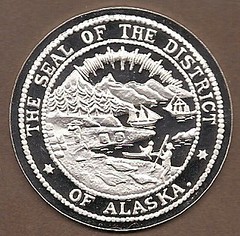
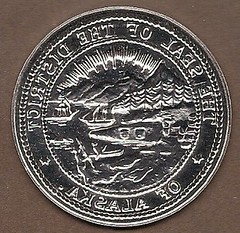
The District of Alaska was the governmental designation for Alaska from May 17, 1884 to August 24, 1912, when it became Alaska Territory. Previously it had been known as the Department of Alaska. Embossed-like striking referred to as a cliché.
To view the eBay lot, see: District of Alaska (Pre-Territory) Cliché Silver Medall (cgi.ebay.com/ws/eBayISAPI.dll?ViewItem&item=370278892699)
The example E-Sylum reader Dick Hanscom writes about is a misuse of the term cliché. This is understandable since it was used by an eBay seller, often the most misinformed people on earth.
A cliché is a one-sided diestruck item, but it is different from a uniface item. It is a special form of a diestruck item. This is the first I have heard of an embossed impression -- or its die -- being called a cliché. Neither of which is correct. The eBay illustration is a positive and negative of the state's seal. A negative embossing die would make a positive impression on paper, thin metal foil or such. It has nothing to do with the making of a true cliché in the numismatic sense.
I wrote on just this subject earlier this year in Medal Collectors of America newsletter in an article titled "Cliché versus Uniface Medal--What's the Difference?" I will extract some data from that article for this reply.
Clichés are made with two thin blanks struck in a press at the same time with a mated pair of dies. The original purpose was to make these as a first strike to give to the artist -- engraver or medallist -- for his initial examination. These are a pair of proof impressions for the artist's approval.
These initial strikes became desirable items, however, that museums requested them for the distinct purpose of being able to display the two designs side-by-side, both obverse and reverse next to each other. Actually clichés could be struck at any time the dies were still correctly positioned in the press, not just initially.
When properly made true clichés will exhibit suction marks or ghosting on the two interface surfaces of the struck pieces. The strongest device -- usually with the highest point of the design -- will form a sunken area on the back side of each blank where metal is drawn from the mass of the blank to fill the incuse area of that die.
On the obverse, for example, this is usually a portrait that forms a sunken impression on its adjacent blank. This indistinct sunken surface sometimes is formed with a wavy surface as the metal flowed from the force of the die.
There is no transfer of the suction movement to the opposite blank. Each blank takes the image of its die alone. The boundary formed between the two blanks is immovable. The suction does not cross over to the second blank.
Since medals are usually multiple struck to bring up the full relief that the artist intended, clichés have to go back on the press just like a solid medal for a second or subsequent blow. It is a problem for the pressman, then, to position both blanks to the correct orientation every time.
Keying clichés. The solution was to key the two blanks to each other. This is done by the pressman who picks up a letter or figure punch -- any punch will do -- about one-quarter inch tall and tap the punch into one of the blanks in several locations.
I have seen these punch marks in three or four places located at the corners of an imaginary triangle or square. With the first blow on the press these indentations cause metal from the opposite blank to flow into these impressions.
For the second or subsequent blow it is then an easy task for the pressman to orientate the two blanks to lock the two blanks in tandem by this keying and rest the two in position on the lower die to be struck again. The correct obverse / reverse alignment is achieved.
Therefore a diagnostic of a cliché is the suction or ghosting on the back of a real cliché and three or four possible punch marks. It is an advantage to have the two matching clichés; but it often happens these become separated in time.
The term cliché comes from the sound the press made when striking these (or from striking a solid piece, as a matter of fact). As presses became heavier, bigger and more powerful the sound became more of a KER-PLUNK instead of a KLE-SHAY.
On the other hand, uniface medals, have a smooth flat back. These are struck with a smooth-faced jack die mated with the die that forms the obverse with the design. Uniface medals are often utilized by attaching to something (book cover, furniture, and such). Frequently a maker's mark, hallmark or other lettering is found punched on the back.
QUERY: COINS AND THE AMERICAN ECONOMY
![]() Being a blogger is all is takes to turn someone into an expert. I was contacted Thursday by a television reporter seeking to interview me about coins and the American economy. The Washington, D.C. area being what it is, the reporter turns out to be the U.S. correspondent for GloboNews, a Brazilian station in Rio de Janeiro.
Being a blogger is all is takes to turn someone into an expert. I was contacted Thursday by a television reporter seeking to interview me about coins and the American economy. The Washington, D.C. area being what it is, the reporter turns out to be the U.S. correspondent for GloboNews, a Brazilian station in Rio de Janeiro.
Reporter Raquel Krahenbuhl wrote:
The story is getting attention in Brazil because coins are being used less and less in the marketplace due to usage of credit and debit cards. Now the Brazilian government is planning to launch a campaign to promote usage of coins."
She offered to come to my workplace for a 10-minute interview, so I agreed. Friday's scheduling didn't work out, but Raquel and her cameraman will show up Monday morning. That will be too late to many E-Sylum readers to help out, but if you have any thoughts or anecdotes to share I'd appreciate hearing them. And for our readers in Brasil (do we have any?), look for the interview this week on GloboNews. If it ends up on the web I'll post a link.
We've discussed some of these topics before. I'd say that there is a gradual trend toward less use of coinage, but I think the change is slower in the U.S. than in other parts of the world. In Asia you can use your cell phone to pay at vending machines, for example. Not here. Most parking meters take quarters, not ATM cards.
The economic downturn has led to a lower demand for coinage (and lower production from the U.S. Mint), but this will bounce back. I think coins will be with us in the U.S. for some time to come, although the lower denominations (cent, and even the five-cent) are endangered, with a worldwide trend toward the elimination of the smallest denominations due to inflation and rising metal prices.
SAINT-GAUDENS' 1905 ROOSEVELT INAUGURATION MEDAL LEATHER POUCH
During the search of the trays, ANS curatorial assistant Sylvia Karges had come across a bronze printing block and a leather pouch, which were apparently specifically made for Saint-Gaudens' 1905 Theodore Roosevelt Special Inauguration Medal.
These had been part of an important purchase made by the ANS in 1961, of items that had come through the family of Augustus' Saint-Gaudens' brother Louis.
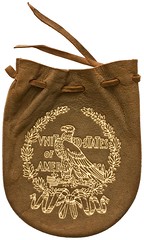
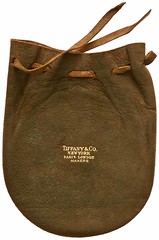
THE BOOK BAZARRE
QUERY: GREEK COIN BOOK SOUGHT
Web site visitor Ben Moore writes:
I have a collection of over 30 Greek coins - most are square, such as Eukratides, Apollo and Lysias. I am new to collecting Greek coins and wonder if there a book or software you can recommend to me.
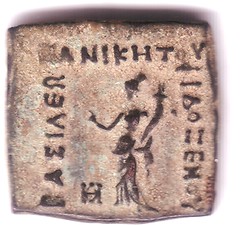
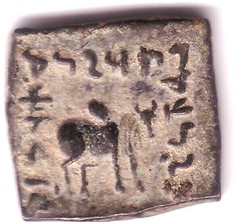
175TH ANNIVERSARY FESTIVAL FOR THE CASA DA MOEDA LISBON, PORTUGAL
Recently on the CoinTalk.com web site Dr Luis Dias wrote:
Our house Casa da Moeda, was a Mint between 1834 to around 1841. (There was a Mint in Goa since 1510, but that building doesn't exist anymore).
We're having a festival to celebrate 175 years since it began life as a Mint (1834-2009), from 8-10 Nov. There'll be talks on various aspects of the building, not all related to numismatics unfortunately. But renowned numismatist Fenelon Rebello will be speaking on 9 Nov.
I made a trip to Casa da Moeda Lisbon, and got more information about the house and the coins from there. I'll be preparing some information material based on my research, for the festival.
To read the complete article, see: Casa da Moeda Goa 175 years (http://www.cointalk.com/t74191/)
Joao Paulo Cota from London writes:
The old Casa da Moeda (Mint House) from Goa is completing 175 years this year and its current owner, Dr Luis Dias and his family are planning a 3 day celebrations plan during 8-10th November 2009 to mark this historical occasion. This would be an unique event for such a famous building where the old coins of Portuguese India were manufactured. Amongst different activities, a commemorative First Day Cover (FDC) is planned to be issued. It will consist of a DL size envelope showing an image of the Casa da Moeda, a relevant Indian stamp of a numismatic nature, a special hand cancel and a card insert with a bit of history about this famous building as well as about their owners, who happen to be very famous ancestors of the current owner. This event will also coincide with the 60th death anniversary of the most famous owner of the building on the 10th November 2009.
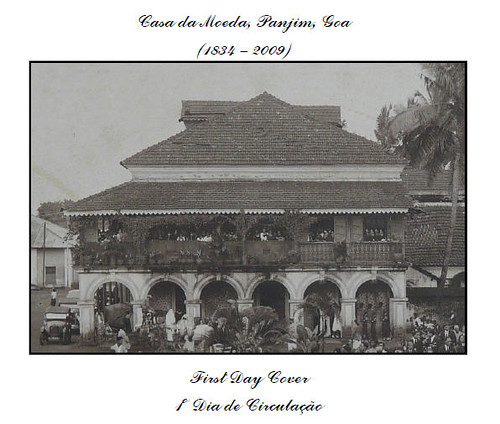
IS BRITAIN'S ROYAL MINT FOR SALE?
 With the cost of everything, it seems, going up in the world, it is prudent to cap rising costs or attempt to find ways to lower and control costs. It was with this in mind that Britain's Chief Secretary to the Treasury launched a study on July 3, 2008. Its report was published April 21st this year. Out of this study came a possible suggestion to privatize Britain's Royal Mint.
With the cost of everything, it seems, going up in the world, it is prudent to cap rising costs or attempt to find ways to lower and control costs. It was with this in mind that Britain's Chief Secretary to the Treasury launched a study on July 3, 2008. Its report was published April 21st this year. Out of this study came a possible suggestion to privatize Britain's Royal Mint.
"Did I read you right? Sell off the Royal Mint?" you might say. Wanna buy a real MONEY making business? Own the mint?
The idea is not as far-fetched as it might sound at first. Even though private industry has to pay taxes, it more often than not can affect efficiencies that government organizations, encumbered with bureaucracies, cannot achieve. The cost of making money could, indeed, be reduced. After all a mint is a factory, and striking coins is a manufacturing process.
And that was the thrust of the British Treasury's study -- how to increase efficiencies. The UK government is dealing in vast sums of money. Even a small efficiency anywhere in the Treasury's widespread activities could save millions of pounds. That was even the name of the study -- Operational Efficiency Programe. Click on the URL below if you wish to read that 86-page report.
News was made this week as the employees of the Royal Mint, based in Llantrisant, Wales, began lobbying lawmakers October 21 to protest such a privatization plan.
Members of Unite [the union of Mint workers] will tell members of Parliament that the Mint, which according to its annual report paid a dividend of four million pounds to the government last year, should be kept in public hands, according to the news article.
This should come as no surprise, both from the human nature of employees' natural inertia, but also from the union's philosophy of protecting all of its members. One might expect under private control, less efficient employees would be dismissed. On the other hand, more efficient employees would be promoted and rewarded. Private industry constantly strives to lower costs, while doing the job at hand, better and faster. Achieving such a goal would be a valid reason for placing control of a mint in private hands.
We do not see, however, privatizing a mint -- any national mint -- coming about in the near future, or setting a trend for other countries' mints. But it would eliminate such irrational behavior as continuing to strike cents in the U.S. that cost 1.4 cents apiece, or five-cent nickels that cost 5.9 cents to make.
Here is this week's news story: U.K.'s Royal Mint Workers Protest Against Privatization Plans (www.bloomberg.com/apps/news?pid=20601102&sid=aAaMmxSg0lfY)
Here is the final report: Operational Efficiency Programme: final report (www.hm-treasury.gov.uk/d/oep_final_report_210409_pu728.pdf)
LONDON NUMISMATIC MYSTERY: ARCHBISHOP'S COINS FOUND IN RIVER
 A fresh mystery is gripping Britain's religious community: Just how did a treasure trove of rare medallions and coins collected by a former archbishop of Canterbury end up at the bottom of the River Wear?
A fresh mystery is gripping Britain's religious community: Just how did a treasure trove of rare medallions and coins collected by a former archbishop of Canterbury end up at the bottom of the River Wear?
The coins, medals, goblets and other religious items were found over the last few years by two divers, Gary and Trevor Bankhead, in the frigid, murky river waters that loop around Durham Cathedral, a Norman-style classic.
Research shows many of the artifacts are linked to the late Michael Ramsey, a former archbishop of Canterbury with longtime ties to Durham, a city 280 miles (450 kilometers) north of London where he served as bishop and spent some of his retirement years before his death in 1988.
"Some of the artifacts appear to have close links to Archbishop Michael Ramsey, who retired to Durham in 1974," the statement read. "These include medals and medallions presented to him during his work and travels as archbishop of Canterbury. There is a silver trowel presented to the archbishop on the occasion of his laying of the foundation stone for a new church in India. Other items include a copper and enamel icon."
In addition, a gold coin apparently given to Ramsey by a Japanese Buddhist leader was found, along with a Russian icon, and precious medals that may have been given to Ramsey when he met Pope Paul VI in Rome in 1966.
"It is not known how these particular artifacts came to be in the river," the statement asserts. "There has been speculation for some time that the archbishop was victim of a burglary and this would seem to confirm it."
But Gary Bankhead does not believe a robbery was involved. Based on the location of the finds, he has concluded that Ramsey himself probably dropped the items into the river.
He thinks some of them were dropped from Prebends Bridge, a popular site near the retirement apartment where Ramsey lived with his wife in their latter years, as a slightly bizarre offering to the people of Durham.
"He was linked to the city since the early 1940s, and it's my belief that he did this as a votive offering to the river and to the people of Durham, who he loved," said Bankhead, who believes the goods may be worth about 25,000 pounds ($41,000).
This unusual interpretation is supported by a friend of Ramsey's who told British newspapers that it is consistent with Ramsey's character that he would have thrown the items in the river.
To read the complete article, see: Former archbishop's treasures found in river (news.yahoo.com/s/ap/20091023/ap_on_re_eu/eu_britain_treasure_mystery)
SOTHEBY'S OFFERS RARE GOLD 1920 FOOTBALL CHAMPIONSHIP MEDAL
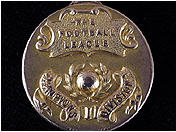 A 1920 Football League championship medal awarded to West Bromwich Albion trainer Bill Barber may fetch up to £5,000.
A 1920 Football League championship medal awarded to West Bromwich Albion trainer Bill Barber may fetch up to £5,000.
The nine carat gold medal is engraved: "The Football League Champions, Division 1, West Bromwich Albion, W.Barber,1919-1920."
It will be auctioned at Sotheby's, London, next Wednesday afternoon.
The medal is rare because 1919-20 was the only time Albion won the Football League title. It was also the first year back for the league after it was suspended in 1916 because of the First World War. Bill Barber was the club's trainer for at least 15 years.
To read the complete article, see: £5,000 hope on cup medal (www.expressandstar.com/2009/10/21/5000-hope-on-cup-medal/)
NEW ZEALAND WAR MEDALS THIEF SENTENCED TO ELEVEN YEARS
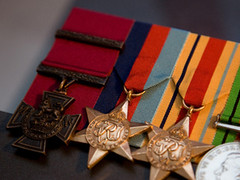 A man who stole war medals from Waiouru Army Museum has been jailed for 11 years.
A man who stole war medals from Waiouru Army Museum has been jailed for 11 years.
The man, who has name suppression, appeared in Auckland District Court today for sentencing, after pleading guilty to the burglary last month.
He was sentenced to six years for the theft of 96 medals, including nine Victoria Crosses, from the museum in December 2007.
Sentencing the defendant, Judge Graham Hubble said the court took a dim view of dabbling in national treasures and holding them to ransom.
He said he gave the man a substantial discount for entering an early guilty plea, returning the medals and the ransom, and the fact that he had stood up in court today and apologised.
The defendant told the court he did not mean to target anyone individually.
"I apologise to all servicemen past and present who served for this country.
"I did it for my own personal gain and I sincerely apologise for everything I've done," he said.
Jim adds:
A related piece of trivia - the accused party was caught and ticketed for speeding on his way to the Museum to steal the medals!
To read the complete article, see: Eleven years for war medals thief (nz.news.yahoo.com/a/-/top-stories/6372915/eleven-years-for-war-medals-thief/)
CHINA GETS A TASTE OF COUNTERFEITING
The Peoples' Republic of China has been in the numismatic hobby news in recent months due to coin replicas originating from China that are being sold elsewhere in the world as genuine coins. This includes coins of Canada, Russia and the United States.
Well, it appears China may be having problems of its own regarding locally produced counterfeit or replica coins. In fact, since China has been one of several countries that in recent years has suffered from a shortage of circulating coinage it appears at least one enterprising organization working outside the government has decided to take advantage of the shortage by making its own coins.
According to the Aug. 6 Guangzhou Daily newspaper, police in Foshan in south China's Guangdong province arrested seven people a day earlier, seizing more than 220,000 counterfeit 1-yuan coins reported to weigh a total of about 1.5 tons.
The 1-yuan denomination, which is the workhorse coin of the Chinese economy, is a nickel-plated steel coin with a diameter of 24.9 millimeters. The obverse depicts the denomination and date, while a chrysanthemum appears on the reverse. The lettered edge repeats RMB three times.
RMB is an abbreviation for renmimbi or "people's currency," which is issued exclusively by the People's Bank of China. The official abbreviation is CNY, but it does not appear on circulating coinage.
According to the Guangzhou Daily newspaper article, "A woman named Liu and her driver were stopped by police when they were seen behaving suspiciously around a Foshan bus station on June 26. The police then seized 18,000 counterfeit 1-yuan coins at the scene and captured a buyer with 1,100 such counterfeit coins. Following the seizure, the police raided Liu's home in Guangzhou and found 200,000 more counterfeit 1-yuan coins wrapped in packages."
The newspaper reported the fake coins originated in Loudi in Hunan province (central China). The counterfeiting operation does not appear to be an isolated incident. According to the newspaper, more than 20 people possessing 1.17 million counterfeit 1-yuan coins were arrested in Loudi in July. In addition "five fake coin plants" were raided in Loudi.
To read the complete article, see: China Battles Domestic Counterfeiters (www.numismaster.com/ta/numis/Article.jsp?ad=article&ArticleId=8038)
VOCABULARY WORD: NUMISMATISM
This summer I consulted at a company in Warrenton, VA. The owner and employees were great fun to work with. I forget how the subject of my hobby came up, but at lunch one day I gave them a lesson in the pronunciation of word "numismatist".
I thought they'd long forgotten about it until another day when I mentioned something about filling out insurance forms. Someone asked whether my "numismatism" qualifies as a pre-existing condition. Good question - it's unquestionably a disease, but are numismatists made or born? And if there were a cure, how many of our spouses would beg the doctor to make us normal?
WAYNE'S NUMISMATIC DIARY OCTOBER 24-25, 2009
This weekend I made a whirlwind trip to Pittsburgh to visit my sister and also my coin friends at the PAN Show. If you haven't been to a Pennsylvania Association of Numismatists coin show in a while, make plans for the next one. After being displaced from their old venue, the show has now landed at a marvelous new facility just a stone's throw from their traditional home in Monroeville, PA.
The new Monroeville Expo Center in Pittsburgh's eastern suburbs is ideal for a coin show. Spacious and brand-spanking new, the facility is actually a completely refurbished big-box store building next to the former Radisson Hotel (soon to be a new Doubletree).
Local collectors came in droves, and the dealers were very happy - several said the show was much better for them than the recent Los Angeles ANA or Philadelphia Whitman show. Bourse chairman John Paul Sarosi and PAN President Kathy Sarosi collected a big stack of applications for the next show (May 7-9, 2010).
I missed it, but I heard the Coins4Kids event drew record numbers, nearly 70 kids. Sam Deep and the PAN officers have expanded the Young Numismatist events in recent years, and in the new facility the PAN KidZone now has a permanent room for nearly full-time activity. I arrived at the show late Saturday afternoon and there were a dozen of so kids happily sifting through piles of donated coins to fill holes in their cent and nickel folders.
I was disappointed to learn when I arrived at the show that I'd just missed former Numismatic Bibliomania Society Secretary-Treasurer Dave Hirt. I chatted with PAN officers John Eshbach, Jerry Kochel and Dick Duncan at the club table, then ran into Sam Deep and Richard Jewell at the exhibit area.
PAN always has some great exhibits. Rich Jewell's exhibit was on Victor David Brenner's Lincoln and other medals. The six-case exhibit held over sixty medals and other items, including a 1907 Lincoln plaque on green marble, a 1900 "Lady at Piano" bronzed galvano, a 1917 painting medallion and a galvano of the reverse of the Carl Schurz plaque. Great stuff, nicely displayed.
Other exhibits included Jerry Kochel's "Half Cent Clip Clock". Arranged around an actual clock face were twelve U.S. Half Cents from 1797-1857, each with a planchet clip at a different position. At Saturday evening's awards banquet, Jerry won first place.
A noncompetitive exhibit was placed by John Eshbach, the 88-years-young winner of the American Numismatic Association's Farran Zerbe award. I'd never seen the Zerbe award before, and the 10K gold medal is beautiful. It's a high honor, and well deserved. John volunteers tirelessly for the ANA and the hobby in general. A true gentleman.
Several folks at the show complimented me on my work on The E-Sylum. Truth be told, it's folks like John Eshbach who inspired me to create it and keep it going all these years. It's my way of giving back to the hobby that's enriched my life in so many ways. John's only complaint about The E-Sylum, delivered with a smile, is that "it's too long." Agreed. Stop sending me all those great submissions, people! (just kidding - don't you dare stop).
I walked around the show floor a bit and spoke to a number of folks, including Paul Schultz, Ted and Blaine Shiff, Dick Gaetano, and Sam Deep. I had an hour to kill before the banquet, so I drove over to the Holiday Inn, found the room, and chatted with the woman setting up the tables and cash bar. With her OK I pulled out my laptop, fired it up and was delighted to connect to the hotel's free wireless network. I brought up The E-Sylum draft and worked on a few stories. Then I grabbed my suit from my car and knocked on the door of John and Dick's room, where they let me change out of my jeans and sneakers.
Properly suited up I joined John Eshbach and Dick Duncan at their banquet table, and a bit later the Sarosis filled the remaining seats. There was a great crowd - about forty people. Before Jerry Kochel kicked off the ceremonies I talked with Tom Sebring. He told me about building and selling his collection of high grade U.S. colonial coins, then building and selling another great collection of shipwreck coins. Tom had an exhibit of shipwreck coins at the show.
Other banquet attendees included PAN's Chairman of the Board Don Carlucci and his family, Dawn and Pat McBride, Corleen Chesonis, Charles "Skip" Culleiton, the Shiffs, Richand and Fran Jewell, Ray Dillard and Tom Uram. Sam Deep sat with our guest speaker Ron Sirna, General Counsel for the American Numismatic Association. Ron spoke about toned coins, and then gave an update on ANA business.
It was a great evening, and I really enjoyed getting to see everyone. Sunday I drove back to Virginia, and once my wife, kids and dog were in bed for the night, I wrote up this diary and published another week's E-Sylum. Good night, all.
SHOPPING FOR BOOKS AT THE WONG FOOK HING
Larry Dziubek kindly forwarded the following photo and caption.
If you can't find the numismatic book
you want…..
You're probably shopping
at the...

If that's not funny enough for you, check out this YouTube video of a book shop owner's encounter with a hard-to-please customer, Yes, it's safe to watch at the office... Mr. Mann and Roy - Bookshop (http://www.youtube.com/watch?v=YbKBrUO8z8Q)
FEATURED WEB SITE: COMMEMORATIVE COINS OF THE BANK OF RUSSIA
This week's Featured Web site is Commemorative Coins of the Bank of Russia, suggested by Jon Radel. He had seen the October 4, 2009 E-Sylum item about the 10-ruble coin commemorating the Russian state of Kaluga and brought one of the coins to our Nummis Nova meeting on October 13th. We agree that the coin is not as impressive in person. The flat relief of a circulating coin makes if difficult to bring to life the detail seen in the image. Still, many of the Russian coin designs are impressive - check them out.
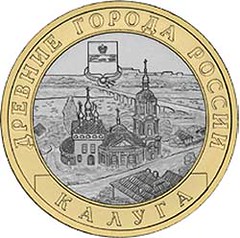
www.cbr.ru/eng/bank-notes_coins/memorable_coins/
